 Review Article
Review Article
qEEG/Brainmapping: An Essential Tool for Assessing Alternative Therapies Beyond Neurofeedback
Fernando Cavallo1* and Bill Brubaker2
1Bryn Athyn College, Department of Psychology, Bryn Athyn, Pennsylvania, USA
2Yang Institute, Bryn Mawr, Pennsylvania, USA
Fernando Cavallo, 2945 College Drive, Bryn Athyn, PA 19009, USA.
Received Date:December 20, 2023; Published Date:January 04, 2024
Abstract
Based on some of our prior research studies and a brief review of current research in the field, the present paper discusses the merits of utilizing qEEG brainmapping as an important tool for alternative therapies, such as Augmented Reality (AR) and Virtual Reality (VR). This paper will also discuss the value of pairing qEEG with psychometric data for research purposes.
Keywords:qEEG; Brainmaps; Virtual Reality; Augmented Reality; VR therapy; Neurofeedback
NFB, qEEG, and Brainmapping
Neurofeedback (NFB) is known by other names: EEG Biofeedback and Brain Computer Interface training are just a couple, where brainwaves are monitored in real-time and “feedback” is provided to the trainee to support relaxation and to teach self-regulation. It falls under the wide umbrella of biofeedback. The first clinical application of this therapy can be traced back to the late 1960’s. (Miller, 1969) [10]. In a relatively short period of time, due to the progress of computer technology, another form of EEG technology has come of age: Quantitative electroencephalography, or qEEG. Many people are familiar with the term Brainmapping and this technology not only helps identify dysregulated brainwave pattern locations, but when applied jointly with NFB, qEEG analysis can assess the therapeutic progress of a specific NFB treatment protocol designed to optimize brainwave pattern functioning. In essence, NFB is a form of biofeedback that enables individuals to change dysregulated brainwave patterns and accompanying neuro-behavioral problems. qEEG is a modern type of electroencephalography (EEG) analysis used by many NFB practitioners to enhance protocol specificity for their clients to provide a more individualized approach to the NFB treatment process. The qEEG process analyzes EEG signals collected from electrodes situated on the scalp and then compares this data using complex mathematical algorithms to a standardized database to identify patterns of atypical brainwave activity.
qEEG is used in many fields to support diagnoses and treatment planning for AHDH, epilepsy and other neurologic and neurodevelopmental disorders (Bailey, 2014) [2]. qEEG has also helped develop a newer form of NFB training known as Live Z-score training (Collura et al. 2010) [6]. This training, which emerged in the beginning of the 2010’s, is now considered a standard therapeutic approach among NFB practitioners. Along with its accepted validity and utility in the therapeutic process, qEEG can also be employed as a powerful tool in assessing non-traditional types of therapies. The current paper discusses a few of these applications involved in research projects completed by the present authors.
Measuring the effects of Augmented Reality using qEEG
Recently, Cavallo et al. (2021) [3], completed a case study which utilized qEGG paired with neuropsychological outcome measures to assess the effectiveness of a novel Augmented Reality (AR) application called Empowered Brain. Empowered Brain uses Google Glass (smart glasses) to present the client with a set of interactive, AR social-emotional learning games to enhance behavioral functioning primarily in individuals diagnosed with Autism Spectrum Disorder (ASD) or inattention/hyperactivity. The recommended session time is 10 minutes per day for 5 days per week; with results appearing as quickly as three weeks of use according to the developers (Sahin et al. 2018) [12]. Cavallo et al. (2021) [3] were the first to collect qEEG data and pair it with standardized neuropsychological assessment and behavioral rating scales to measure the efficacy of the Empowered Brain AR treatment protocol. The pilot study involving 5-8 students diagnosed with ASD was reduced to a single case study due to school closures in early 2020 due the covid-19 pandemic. After 15 sessions of the AR treatment protocol completed over the course of four weeks, the pre-post data presented below yielded significant changes. Furthermore, by measuring pre-post qEEG data, Cavallo et al. (2021) [3] determined that the AR-based treatment had a positive impact on the individual’s dysregulated brainwave patterns as specific brain regions matched up with the improvements in the neuropsychological assessment data depicted below (Figure 1A and Figure 1B).
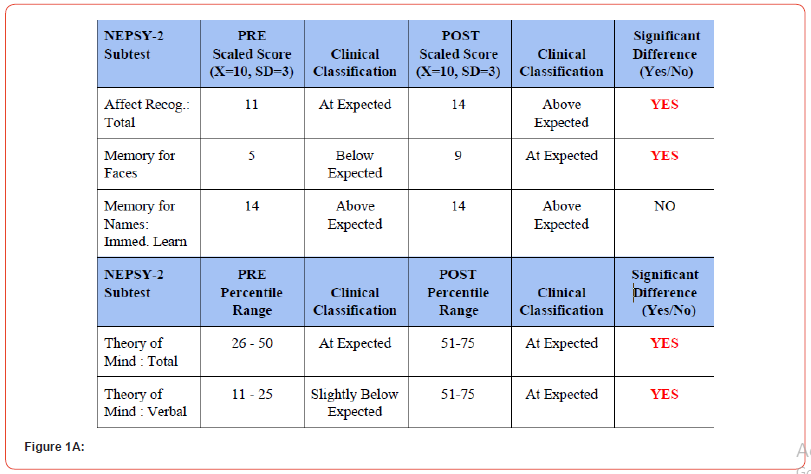
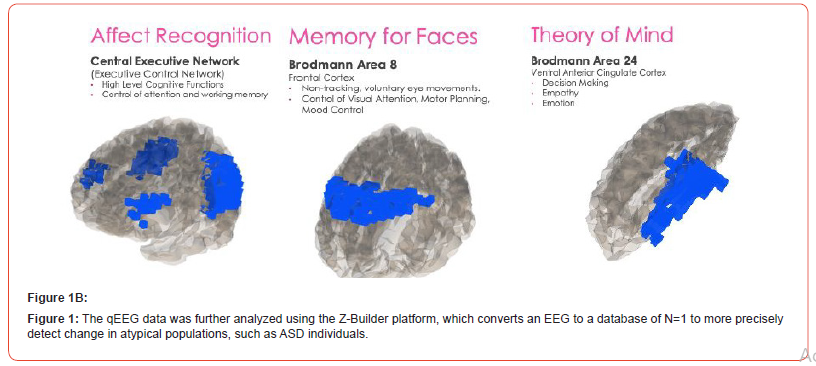
Measuring the effects of Virtual Reality using qEEG
Another pilot study conducted by Cavallo and Brubaker (2023) [4], examined the effects of twodimensional (2D) versus three dimensional (3D)/VR exposure. Below are brainmaps depicting the difference in brainwave frequency band activations for an individual watching the same video content for a concussion training module (Crash Course). The brainmaps below show some notable differences in the beta frequency band and overall coherence and symmetry favoring the 3D-VR exposure. It is hypothesized by the current authors that this indicates a “beta shunting” effect, which allows for an immersion experience due the lowering of beta bandwidth, which would allow a person to be more in the low-beta range, which is often a peakperformance state referred to as being in the “zone” or cognitive “flow.” (Figure 2).
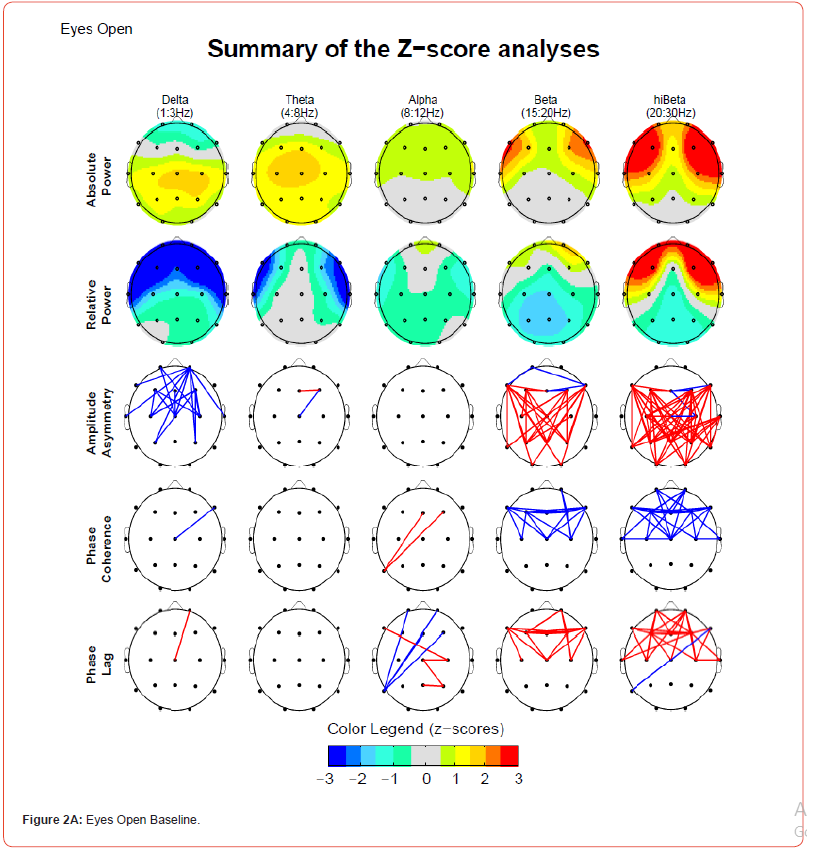
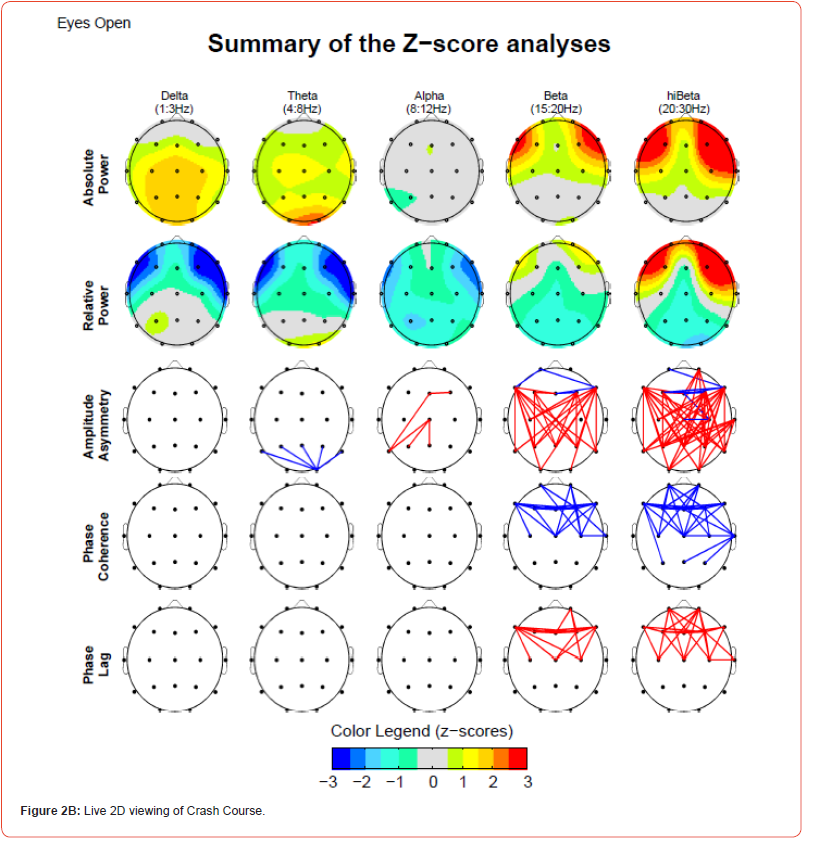
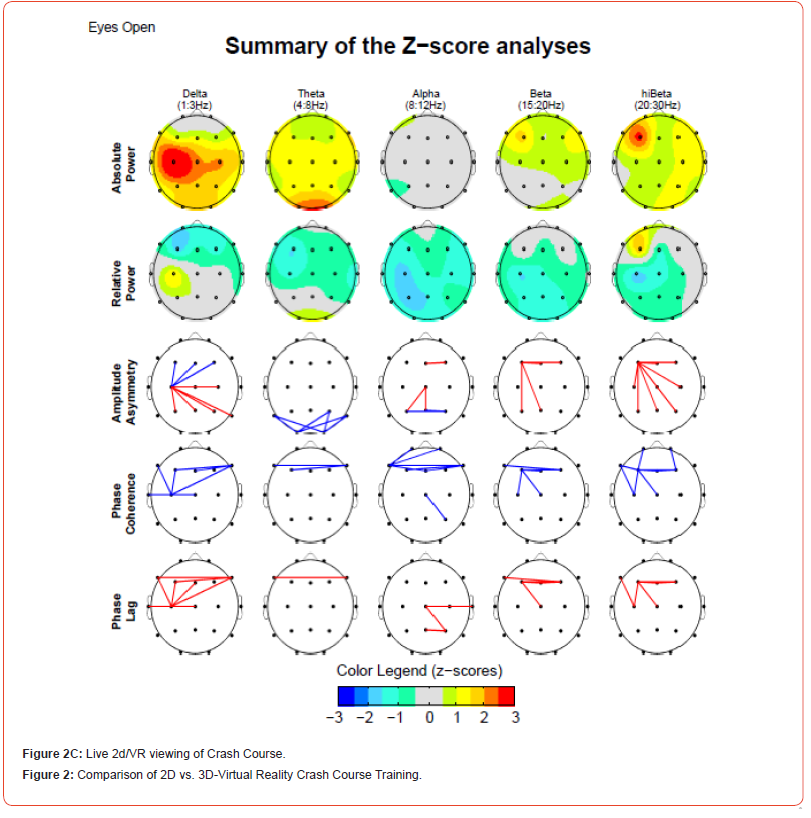
In fact, recent research provides evidence that in a contextdependence foreign language learning task using VR training, participants were better able to recall and retain learned information along with follow-up brain imaging studies confirming the reinstatement of brain activity patterns associated with the original encoding context during word retrieval were also activated during improved recall performance (Essoe et al., 2022) [7].
Establishing efficacy using qEEG for Virtual Reality as a reliable outcome measure
Cavallo et al. (2023) conducted a review of the scientific literature and found that over the past several years the application of VR for mental health treatment has increased and is also supported by the American Psychiatric Association (APA, 2021) [1]. VR therapy is being promoted nationally and internationally by companies such as Amelia Virtual Care (Gurr & Laitz, 2023) [9] based upon clinical case studies that rely upon subjective outcome variables. In fact, EaseVRx recently received FDA approval for their VR treatment for patients 18 years or older diagnosed with chronic lower back pain (FDA, 2021) [8]. Based upon the growing use of VR treatment for psychological and physical disorders, it would be important to establish whether valid qEEG data can be reliably obtained while actively engaged in a VR treatment involving a VR headset situated on top of an electrocap in order to validly make comparisons between 2D and VR treatment modules. In an attempt to address this gap in the literature, Cavallo et al. (2023) [5] sought out to determine whether or not the VR headset itself causes any difference in the qEEG data collected by comparing the resting eyesopen condition for qEEG baseline acquisition while wearing the VR headset to the resting eyes-open condition without the VR headset. Cavallo et al.’s (2023) [5] results revealed very minimal significant differences between the two conditions (n=28) when analyzed collectively and no significant differences for the male participants. This study also provided preliminary support for confidently reporting qEEG efficacy data involving the use of a VR headset. This study also established a valid and standardized approach for reliably obtaining active or real-time qEEG data while wearing a VR headset in order to confidently report the physiological effects of VR immersion on electrical brain activity as depicted in the illustrations below (Figure 3A and Figure 3B).
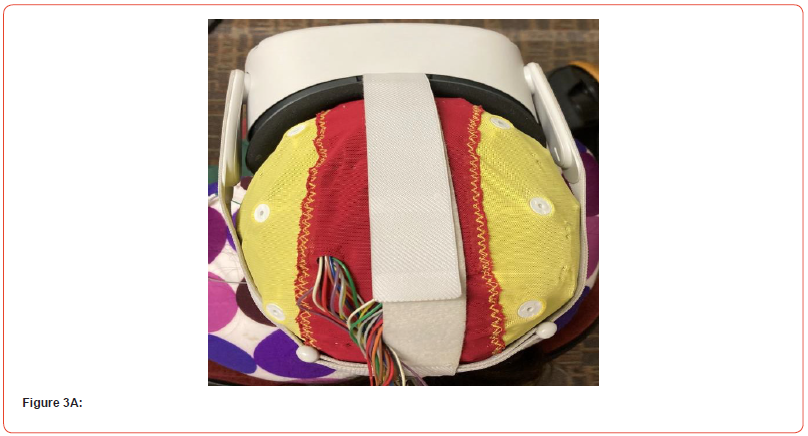

Future Directions & Implications
The collection of research presented in this review is designed to inspire and also encourage researchers and clinicians to incorporate qEEG as an essential tool for measuring efficacy for various treatment modalities. Efficacy robustness for clinical research involving NFB and other treatment modalities is further enhanced when pairing physiological brain data (qEEG) with direct neuropsychological assessment and the Z-builder qEEG analysis model for clinical populations. Finally, some of our recent research and case studies provides evidence, based upon qEEG findings, that VR may provide users with an enhanced learning experience due to its potential to engage positive regional brainwave activity across specific frequency bands associated with increased focus and attention, increased visual sensation activation and processing, and a decrease in sensory avoidance (Cavallo, 2023) [5]. In fact, this notion of VR’s immersive properties is being applied as an enhanced learning modality for medical students’ simulation training (Pottle, 2019) [11] to improve their learning experience and skill development. ikewise, the use of VR assisted educational tools in broader fields of education is also promising. As technology continues to advance not only our understanding of brain processes, but is also resulting in advanced treatment modalities, the current authors believe qEEG’s capabilities extend beyond its traditional use as an adjunctive diagnostic tool for the identification and treatment of common neurodegenerative disorders. That is, qEEG can be employed as an integral part of assessing the efficacy for newer fields of studies seeking to enhance brain performance, such as photobiomodulation, VR therapy, NFB Live Z-score training, psychedelic drug treatment, and transcranial magnetic stimulation (TMS), to name a few.
Acknowledgement
None.
Conflict of Interest
No Conflict of interest.
References
- American Psychiatric Association (2021) Expanding mental health users for virtual reality. https://www.psychiatry.org/News-room/APA-Blogs /Expanding-Mental-Health-Uses-for-Virtual-Reality
- Bailey T (2014) Diagnosing and treating developmental disorders with qEEG and neurotherapy. Academic Press: Clinical Neurotherapy: 321-355.
- Cavallo F, Brubaker H, Brown T (2021) Utilizing individual z-scores to measure efficacy of the world’s first augmented reality glasses for autism: A single case study. Journal of Social Sciences Research (1): 54-71.
- Cavallo F, Brubaker H (2023) Efficacy of VR qEEG Acquisition. (Workshop Presentation). International Society for Neuroregulation & Research (ISNR). Annual Conference, Dallas, TX.
- Cavallo F, Brubaker H, Bruckner E, Castro S (2023) A preliminary study investigating the acquisition of valid qEEG data while wearing a virtual reality (VR) Headset. Neuroregulation 10(3): 170-178.
- Collura T, Guan J, Tarrant J, Bailey J, Starr F (2010) EEG biofeedback case studies using live Z-Score training and a normative database. Journal of Neurotherapy: Investigations in Neuromodulation, Neurofeedback and Applied Neuroscience 14(1): 22- 46.
- Essoe JK, Reggente N, Ohno A, Bawek Y, Dell’Italia J, Rissman J (2022) Enhancing learning and retention with distinctive virtual reality environments and mental context reinstatement. With distinctive virtual reality environments and mental context. Npj Science of Learning 7: 31.
- Food and Drug Administration (FDA) (2012) FDA authorizes virtual reality system for chronic pain reduction.
- Gurr H, Laitz EK (2023) Clinical evidence of virtual reality in mental health treatment [Webinar]. [Online]. Amelia Virtual Care sponsored by American Psychiatric Association, April 21, 2023.
- Miller NE (1969) Learning of visceral and glandular responses. Science 163: 434-445.
- Pottle J (2019) Virtual reality and the transformation of medical education. Future Healthc J. 6(3): 181-185.
- Sahin NT, Abdus-Sabur R, Keshav NU, Liu R, Salisbury JP, et al. (2018) case study of a digital augmented reality intervention for autism in school classrooms: Associated with improved social communication, cognition, and motivation via educator and parent assessment. Frontiers in Education, 3(57): 1-13.
-
Fernando Cavallo* and Bill Brubaker. qEEG/Brainmapping: An Essential Tool for Assessing Alternative Therapies Beyond Neurofeedback. Arch Neurol & Neurosci. 16(3): 2024. ANN.MS.ID.000887.
-
Acute Polyradiculoneuritis, Neurology, Guillain-barre; Fann teaching hospital, neuropathy, cranial nerves, immunotherapy, Neuroscience, neurogenic syndrome, epidemiological, Dysphonia.
-

This work is licensed under a Creative Commons Attribution-NonCommercial 4.0 International License.






